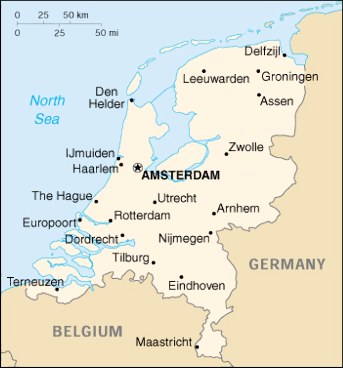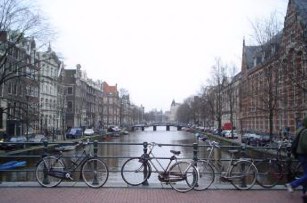The Netherlands
Travel The World

Name: Netherlands ( Nederland) or Kingdom of the Netherlands
( Koninkrijk der Nederlanden )
The name means "lowlands".The people in Holland (another name for this country) are called the Dutch.In terms of size it's relatively small.
The country is wellknown for it's many rivers,canals and channels crisscrossing the land.Then there are many dikes and sanddunes protecting the land and it's people from flooding.
Capital: Amsterdam
Administrative divisions: 12 provinces; Drenthe, Flevoland, Friesland (Fryslan), Gelderland, Groningen, Limburg, Noord -
Brabant, Noord-Holland, Overijssel, Utrecht, Zeeland, Zuid-Holland.
Ethnic groups: Dutch, and others 17% (of which 9% are non-Western origin mainly Turks, Moroccans, Antilleans,
Surinamese, and Indonesians.
Religions: Roman Catholic, Dutch Reformed, Calvinist, Muslim, and others.
Languages: Dutch (official), Frisian (official)
Coastline: 451 km
Terrain: mostly coastal lowland and reclaimed land (polders); some hills in southeast
Netherlands: Sign of Prosperity
If you ever need to name a country which qualifies as the best example of liberalism, modernity and prosperity, Netherlands
is the best suitable to mention. This ‘big’ small monarchy in the Northwest of Europe has much more than windmills, cheese, tulips and
wooden shoes. Netherlands lies between North Sea, Belgium and Germany. The golden period of this country was during 17th century
when Dutch Empire vastly expanded to New York, parts of India, forts along the African coast and
some Indonesian colonies.
During its overseas expansion and industrial revolution in 19th century, some notable architecture became a part of the Netherlands’ cities.
Amsterdam and Leiden possess some big baroque mansions of 17th century which belonged to rich merchants of the city—they were commanders of Dutch fleet.
Painters and paintings have been the most famous assets of Netherlands. Dutch feel proud of their bunch of world famous painters like Rembrandt, van Gogh,
Frans Hals and Johannes Vermeer and their exclusive paintings.

Besides the glorious 17th century history, it features many other interesting things. First of all, the relaxed, open and international atmosphere invigorates the tourists to spend more time here.
Some excellent museums and great historical monuments are there in different cities.
Amsterdam, Rotterdam and Maastricht are some of the most visited cities in Netherlands. Rotterdam is worlds largest
seaport. Destinations like Den Bosch ('s Hertogenbosch) and Arnhem and Zwolle, too, have a lot for you to see. And if love cycling, it may
prove to be a exciting opportunity to explore the country on bicycle — Netherlands is Flat and adequately sized.
The Dutch language
Dutch language started to take shape at the middle of the 5th century AD. The language spoken by the inhabitants of the Netherlands
back then was called Old Dutch and it developed from Lower Franconian (Niederfränkisch), a dialect of Low German.
Middle Dutch was the language used during the 12th and the 15th century and since the year 1500 we can speak of Modern
Dutch, a language very similar to Standard Dutch, the language currently used by the Dutch people. Standard Dutch is
called "Algemeen Beschaafd Nederlands" meaning "general civilized Dutch".
The name of the Dutch language comes from the word Dietsc / Duutsc (language of the people), as people used to call it in
the Middle Ages.
Dutch is a West Germanic language spoken in the Netherlands, Belgium, Suriname and other Dutch colonies, as well as
in small parts of Germany and France. It has an official status in the Netherlands, Flanders, Suriname, Aruba and the Netherlands
Antilles and it manages to sum up around 23 million native speakers worldwide (15 million residing in the Netherlands).
Dutch used to be the official language of South Africa until 1961, contributing to the development of Afrikaans,
one of the official languages of South Africa. Dutch has several dialects, the most important being Flemish, spoken in
Flanders (Belgium). Compared to Standard Dutch, it uses older words and a softer pronunciation.
Like the other Germanic languages, Dutch uses the Latin alphabet. As a particularity, it contains the group of letters "3"
that stands for the more common "y" which is used only in foreign words. Dutch language has three genders (masculine, feminine and neuter) but
they are quite often reduced to two (common and neuter). Cases are used mainly for pronouns, while common nouns and adjectives are not case inflected.
The Dutch vocabulary is predominantly of Germanic origin and it is one of the richest in the world, containing approximately 190,000 words.
Other particularities of the Dutch language are the extensive use of doubled letters (mostly due to the formation of compound words) and the devoicing of
all consonants at the end of the words.
Holland Money
The Dutch guilder used to be the official currency of the Netherlands. When the European Union was formed in 1993,
the Netherlands became a member country. On 1 January 1999, the European Monetary Union introduced the Euro as a universal currency to
be used by financial institutions in member countries. Three years later, on 1 January 2002, the Euro became the sole currency for everyday
transactions within the member countries. The Netherlands was the first of the 12 member countries to put its currency entirely out of circulation.
The Dutch guilder passed into history with the introduction
of the Euro which became the official unit of currency of Holland. Since then, Euro banknotes and coins have been in
circulation and are an integral part of daily life in Holland.
Amsterdam museums
Museum Amstelkring - Hidden church and religious artefacts.
Ouderzijds Voorburgwal 40; By tram: 4,9,16,20,24,25
Open: 10am-5pm Mon-Sat, 1-5pm Sun and public holidays; Closed 1 Jan, 30 Apr.
Rijksmuseum - Dutch art, masterpieces from 17th century.
Stadhouderskade 42; By tram: 2,5,6,7,10,20; By boat: Stadhouderskade
Open: 10am-5pm daily; Closed 1 Jan.
Amsterdam Historical Museum - History of Amsterdam.
Kalverstraat 92, Nieuwezijds Voorburgwal 3457, St Luciensteeg 27; By tram: 1,2,4,5,9,13,14,16,17,20,24,25
Open: 10am-5pm Mon-Fri, 11am-5pm Sat-Sun; Closed 1 Jan, 30 Apr, 25 Dec.
Stedelijk Museum Amsterdam - Modern Art, Picasso, Cézanne, Monet.
Paulus Potterstraat 13; By tram: 2,3,5,12,16,20
Open: 11am-5pm daily; Closed 1 Jan, 30 Apr, 25 Dec.
Allard Pierson Museum - Archeological museum.
Oude Turfmarkt 127; By tram: 4,9,14,16,20,24,25
Open: 10am-5pm Tue-Fri, 1-5pm Sat,Sun, public holidays; Closed 1 Jan, Easter Sun, 30 Apr, 1 May, 25 Dec.Van Gogh Museum - Van Gogh's paintings.
Paulus Potterstraat 7; By tram: 2,3,5,12,16,20
Open: 10am-5pm daily; Closed 1 Jan.
Anne Frank House - A secret place where Jewish girl was hiding during the war.
Prinsengracht 267; By tram: 13,14,17,20
Open: Apr-Aug 9am - 9pm daily, Sep-Mar 9am - 7pm daily; Closed Yom Kippur.
Netherlands Maritime Museum - boats, ships, models, naval history.
Kattenburgerplein; By tram: 22,32; By boat: Oosterdok, Kattenburgergracht
Open: Tue-Sun 10am- 5 pm, mid-Jun - mid-Sep Mon-Sun 10am - 5pm; Closed 1 Jan, 30 Apr, 25 Dec.
Jewish Historical Museum - Jewish history, religion and culture
Jonas Daniël Meijerplein 2-4, by tram: 9,14,20; metro Waterlooplein
Open daily 11am-5pm, Closed Yom Kippur (25 September)
Museum Willet-Holthuysen - 17th century house, paintings, glass, silver.
Herengracht 605; By tram: 4,9,14,20; Open: Mon-Fri 10am- 5 pm, Sat & Sun 11am -5pm; Closed 1 Jan, 30 Apr, 25 Dec.Holland Travel – Amsterdam, Van Gogh, Anne Frank
Holland certainly has a reputation with travelers. Known for having a very liberal attitude on social issues such as
prostitution and drugs, the reputation is not always deserved. Yes, marijuana and prostitution is legal, but there is so much more to the country.
Many look at Amsterdam as Holland, but visitors know there is much more. If you desire to travel to Holland, also known as the Netherlands, don’t miss these attractions.
Amsterdam
Simply put, Amsterdam has something for everyone. The city is an incredibly beautiful collection of old world European
architecture elegantly partitioned by canals. In truth, the city is built on roughly 90 small islands, although you can hardly tell. Transportation is
best undertaken on foot or by bicycle.
With a cool climate, you’ll barely break a sweat.
Contrary to popular opinion, Amsterdam is not just a city of liberal policies. Yes, coffee bars sell things other then just coffee.
Yes, there are women in windows that are awfully friendly. Still, there is so much more to experience in the city.
Van Gogh Museum
The Rijksmuseum Vincent van Gogh houses the world's largest collection of the work of Vincent van Gogh. From his early
work, the museum contains 700 artistic works and 850 letters. After moving to Paris in 1886, van Gogh entered an impressionist period, of which
the museum contains a large collection. Perhaps the most interesting thing about the
collection is the organization. The entire collection is arranged chronologically from the first to last work. As you walk, you
can clearly see the evolution of this master’s skill.
Anne Frank House
Who hasn’t read the intense diary of Anne Frank? Hiding from the Nazis, she and her family lived in an annexed section of
an apartment in Amsterdam for two years. In 1957, the house was donated to the Anne Frank Foundation and turned into a
museum. A visit will send chills through your spine. The museum contains films, the annexed area and the original notes of Anne Frank.
A must see for anyone traveling to Amsterdam.
Beyond Amsterdam
For those needing a break from Amsterdam, there is much to be seen in Holland. If you are looking for a color explosion,
consider taking the bulb cycling tour out of Noordwijk. Windmills your thing? Head to the De Zaan district to see them in
action. Prefer to spend a night in a castle? Try the Castle Hotel Engelenburg, which even lets you ruin a good walk by
playing golf.
Travel to Holland and you won’t regret it. Whether you want to “investigate” the countries liberal policies or simply bike
through fields of tulips, Holland will satisfy.

Vincent Van Gogh, the Tragic Story of a Brilliant Painter
Twelve years after his tragic suicide, Vincent’s work was discovered by a Parisian art dealer. Until then, no one, except for those
who knew him personally, had ever even heard the name. Today, large sums of money are exchanged for his work.
Vincent was born in the Dutch village of Zundert, in the south of the Netherlands.
He studied theology and became a preacher in the Methodist Church.He also worked for several different art dealers in The Hague,
London and Paris. Only in 1880 does he start painting, first traditional and very “Dutch”, reflecting the Dutch rainy climate with many dark brown colors.
In 1886 Vincent moves to Paris, and two years later to Arles, on the Mediterranean, near Marseille. On the 20th of October of that year, Vincent’s friend Gauguin joins
him in Arles.
Vincent’s art becomes lighter in color, showing the Mediterranean
sunlight in it. Two months after Gauguin comes to Arles, Vincent has a schizophrenic episode and cuts a piece of his own ear off. The years following,
Vincent starts to get very sick, and he eventually kills himself in 1890. His brother, Theo van Gogh, who
had supported Vincent all of his life, dies seven months after Vincent, possibly from grief.Van Gogh never sold a painting in his life. Today, his paintings
are the mostexpensively sold in the world, and are admired around the globe in many museums and private collections. He also is celebrated as the
forerunner of the expressionist movement.